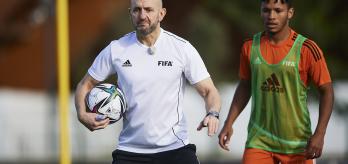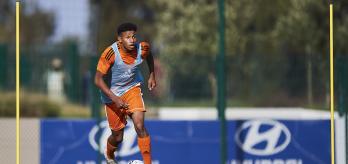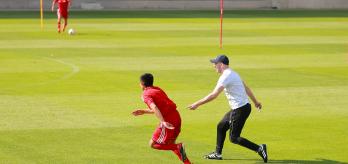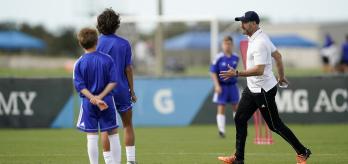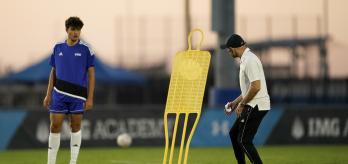A central element of this training method is the combination of tempo, technique, movement, timing and speed, along with technical coordination and passing quality. The circuit 6 drills provide high-volume training that targets these functional qualities, with an emphasis on repeat high-speed running (HSR) and collective technique in each drill rotation.
The focus of the circuit 6 drills is on repetition, with speed exertion a differentiating factor compared to all of the other circuits available on the FIFA Training Centre. This is emphasised in most of the circuit 6 drills, in which players are required to perform two consecutive high-speed exertions with virtually no recovery time within each out-and-back circuit rotation, with an outbound exertion towards the far end of the circuit and an inbound exertion returning to the start position. A unit of two or three players power out and combine technically, before playing a one-two with the coach or ball-serving player to facilitate the high-tempo return to the start position. The repeat exertion elevates the physical speed component of the drills and challenges the players’ ability to consistently play high-quality longer passes while at working at speed.
The circuit 6 drills involve typical in-game movement scenarios, which are adapted to fit the repeat speed format. These include – amongst others – powering forward with the ball to play in the wide player running in behind or combining players’ vertical speed in coordination with the technical quality to switch the play diagonally at speed from one corner of the circuit to the other. Additionally, the out-and-back format also enables a variety of technical interaction within individual drills, with players often performing a different movement sequence for the inbound rotation compared to the outbound aspect of the drill.
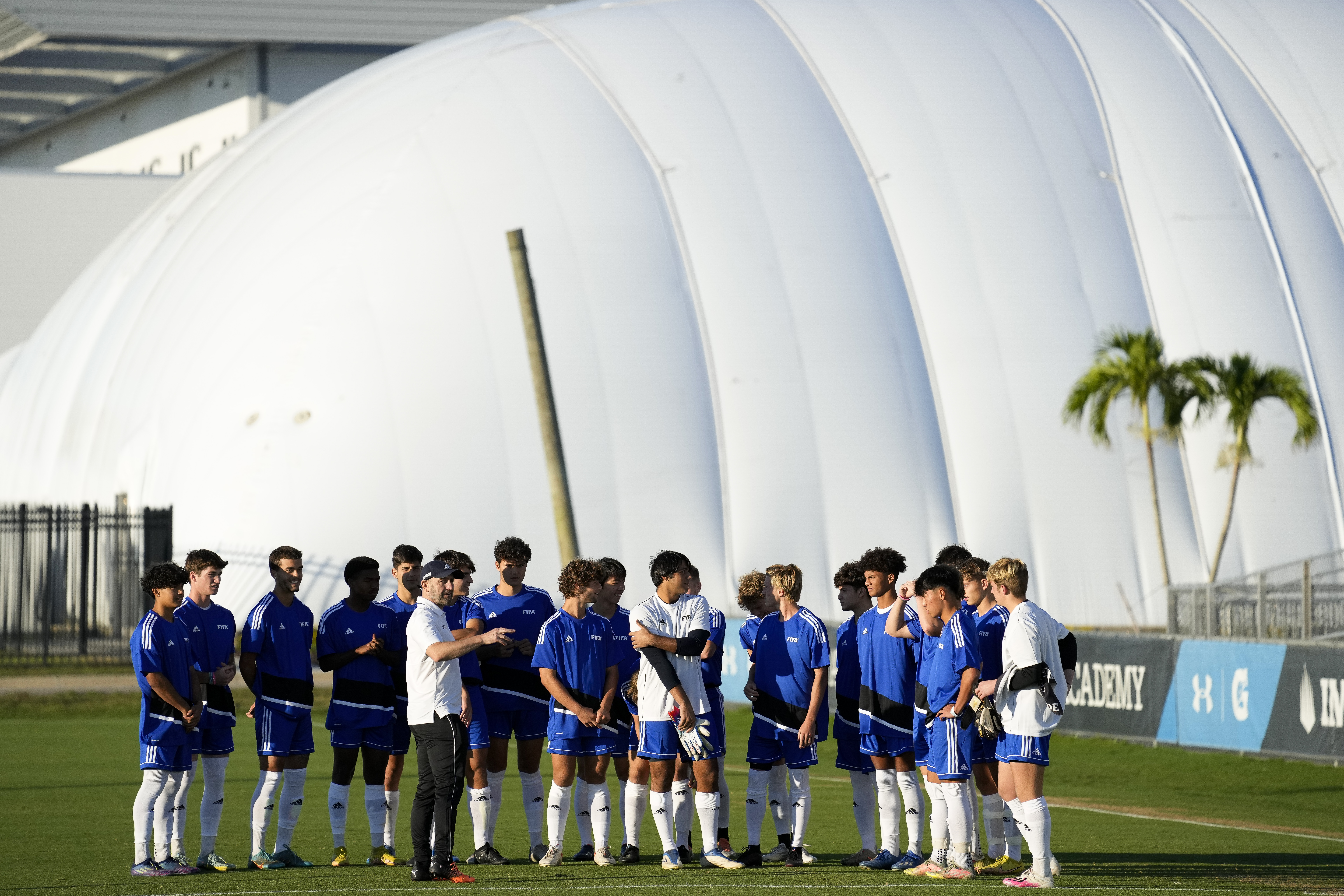
Accelerations and HSR reproduce various angles of movement seen in match play. Furthermore, efficiency of movement, the technical balance of two-footedness and good footballing habits are all priorities within each drill.
Circuit 6 features four grid sizes, ranging from very small to large, that determine the sprint and HSR distances and the passing ranges involved in the drills. The decision regarding which grid size to use may be based on the age group of the players. All four of the circuit 6 drills involve one ball in rotation and a minimum of four to five players and a maximum of nine players. The fewer the players involved, the greater the overall workload intensity. For the purposes of this article, the medium-sized grid has been selected to display the drills. The HSR distances range from 15 to 60 metres for each out-and-back rotation.
A table featuring speed metrics and workload intensity is provided at the end of each session plan. It offers approximate figures regarding the distance covered in the sprint/HSR zones and information on the intensity of all the exercises relative to the player numbers. A table detailing the player starting positions is also provided for all drills to ensure that all players (between four to nine players) take up the correct starting position.
Set-up for all drills

Organisation
- Lay out a 45x40m grid using flat white discs or cones (a and b).
- Mark out a 34x30m inner grid using four mannequins (c and d).
- From the midpoint of the grid, create three 7-metre-wide gates using mannequins and flat discs. Position the mannequin gates 30m apart (e) and 15m from the middle gate (f).
- Set up 7-metre-wide starting gates using flat discs or cones at each end of the outer grid (g), positioned 15m beyond the mannequin gates (i).
- Place two mannequins 40m apart along the midpoint of the grid (h).
- If no mannequins are available, a mixture of poles, cones or flat discs may be used instead.e gates using mannequins and flat discs.
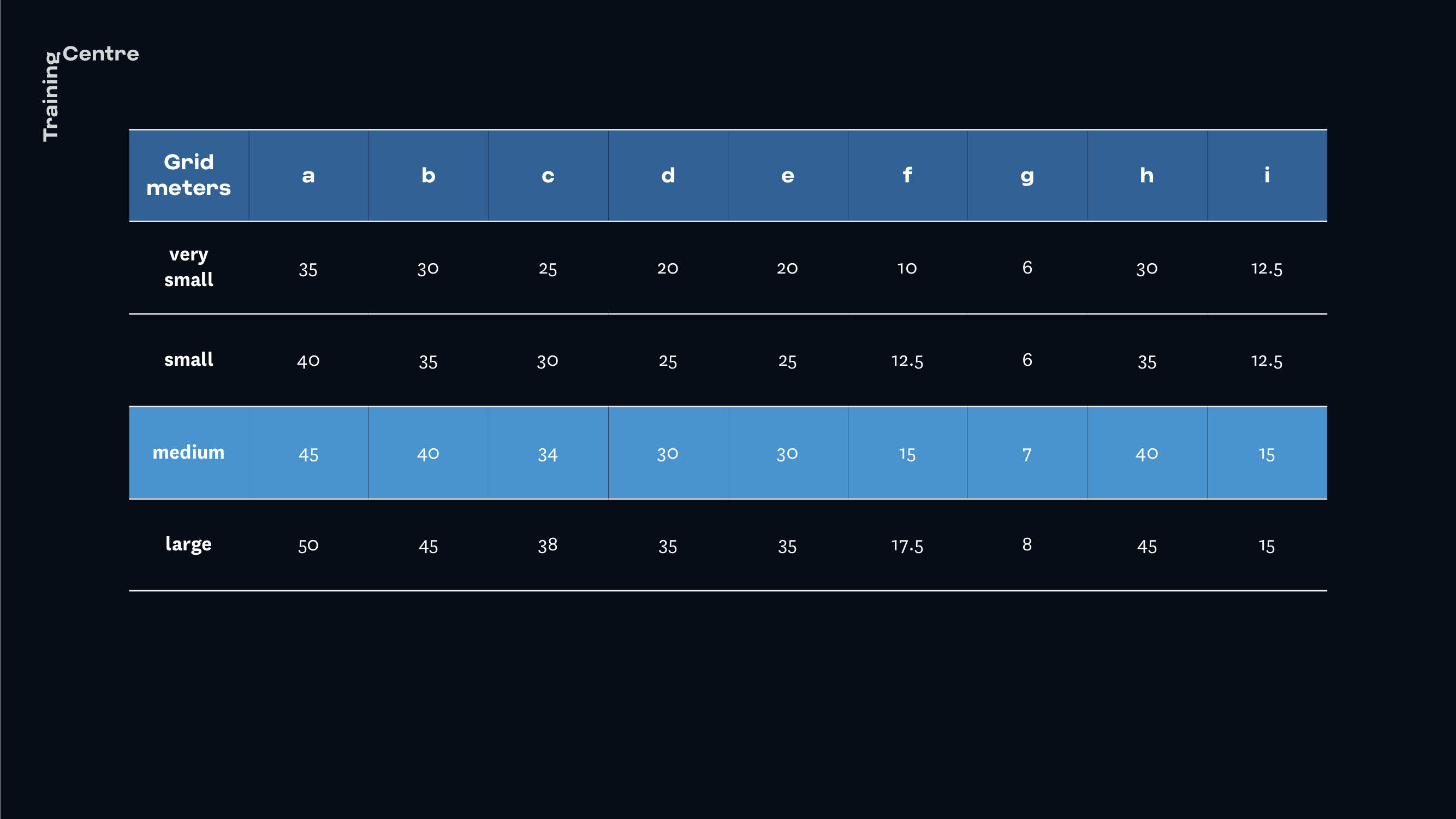
Drill duration
- 4 players: 5-6 minutes ball‑rolling time
- 5 players: 6-7 minutes ball-rolling time
- 6 players: 7-8 minutes ball-rolling time
- 7 players: 8-9 minutes ball-rolling time
- 8 players: 9-10 minutes ball-rolling time
- 9 players: 10 minutes ball-rolling time
Approximate workload intensity
- 4 players: maximal
- 5 players: very high
- 6 players: high
- 7 players: high to medium
- 8 players: medium
- 9 players: low
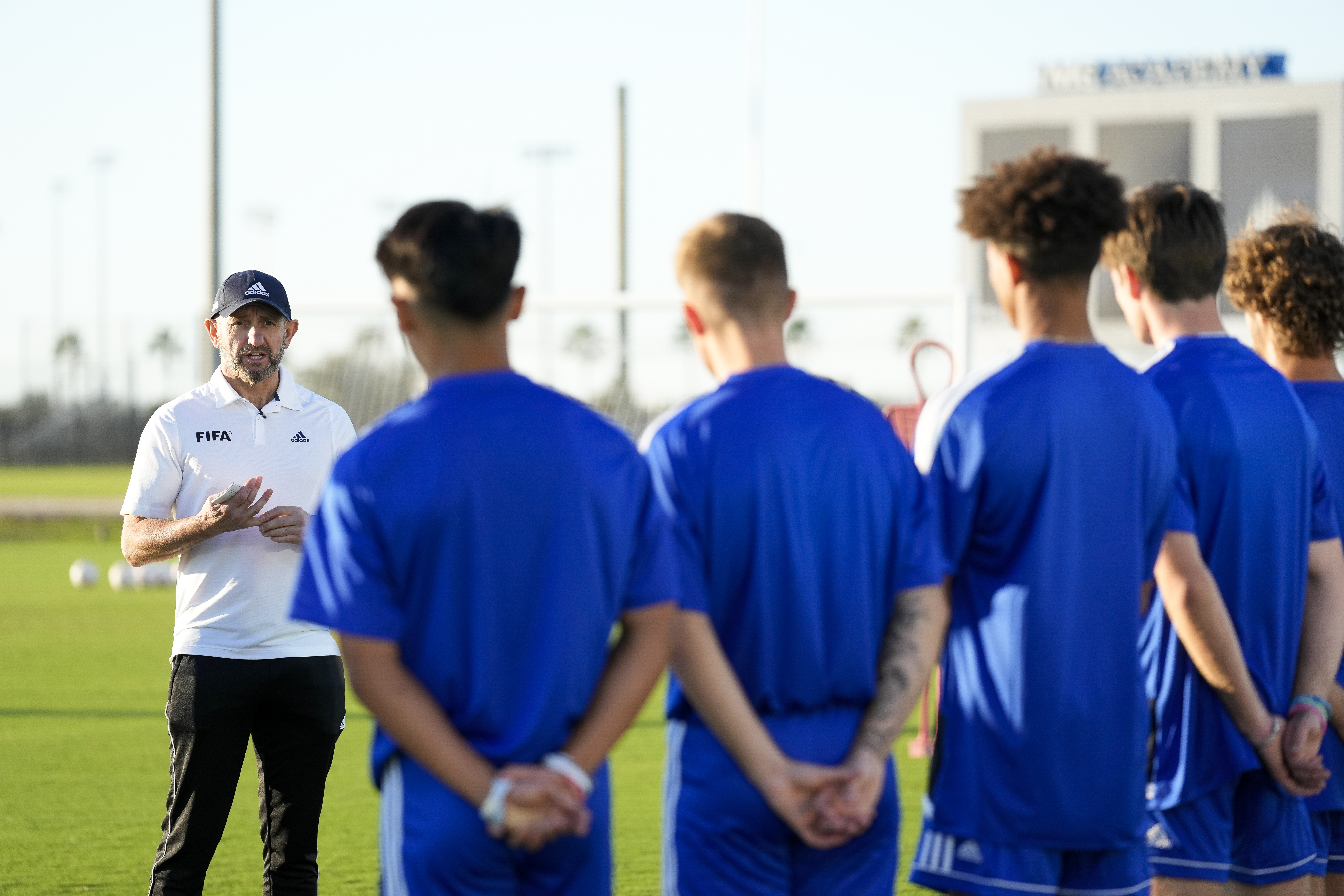
Coaching points that apply to all drills
- Give players one to two minutes to find their tempo and familiarise themselves with the scenario, before gradually raising the tempo and intensity.
- Devote a period of time (minimum of four minutes) during each drill to focus on high tempo, correct technique, technical balance (two‑footedness) and the reinforcement of awareness habits.
- The drill duration relates to ball‑rolling time. Stop the watch if the drill is interrupted for more than a few seconds.
- All drills involve full left and right rotations of the ball, which ensures overall technical balance for the circuit. However, for even player numbers (e.g. 4, 6 and 8) the coach has to swap the individual rotation order of the players at the midpoint of the drill, with players who previously rotated to the left of the circuit asked to rotate to the right and vice versa.
- Encourage players to move quickly between positions. This is particularly relevant when there are few players involved in the drill, e.g. 4 or 5 players.
- Place the emphasis on playing a quality pass into the path of the next player in the sequence.
- Players should play with their heads up, scanning the area they are receiving the pass from and the intended destination of their pass.
Drill 1: long straight in-behind run and a long curved in-behind run infield
Rotation 1: outbound
- A drives with the ball beyond the yellow mannequin gate then plays a diagonal pass into B’s HSR path.
- After making a long run in the HSR zone from the wide starting position, B meets the ball and plays a diagonal pass into the coach/server player’s forward path.
Rotation 2: inbound
- After powering past the opposite end mannequin gate, A moves wide of the gate to receive an angled pass from the coach/server. Turning forward with their first touch, A then plays a second diagonal pass to meet B’s repeat run in the HSR zone.
- After making a long curved in-behind run in the HSR zone to latch onto A’s pass, B plays a cross-field pass into the forward movement of the next A.
- The next rotational sequence continues with passing and movement using the opposite side of the circuit grid.
-
Players change positions after each rotation.
-
A moves to position B on the same side of the grid as the pass they played to B.
-
B moves quickly to position A.
-
Place the emphasis on playing a quality pass into the path of the next player in the sequence.
-
This drill promotes technical balance, requiring the use of the left and right foot in equal measure. However, with even player numbers, the coach is required to swap the order in which the players rotate to ensure that players rotate to both the left and right sides of the grid, which requires the use of the left and right foot in equal measure.
-
A should step in to meet the ball, powering forward between the mannequins, before getting their head up and playing the pass out to B.
-
Before receiving the ball from the coach/server half-turned and on the move, A should scan across to B to assess the timing, weight and placement of their pass to B.
-
To promote technical balance, from either end of the grid, A should be encouraged to use both their left and right foot to play the long diagonal passes to B.
-
To reinforce good footballing awareness habits, in rotations 1 and 2, B should scan infield to time their run in the HSR zone from both wide positions to A’s movement, touch and pass.
-
To promote technical balance, when playing the diagonal pass from left to right to the coach/server, if possible, B should meet the ball with a first-time left-footed pass directed into the coach/server’s forward path. The opposite applies when playing the right-to-left diagonal pass to the coach/server, when the emphasis should be on playing a right-footed pass.
-
To promote technical balance, when playing the diagonal pass from right to left to the next A, B should play a right-footed pass into the next player’s forward path. The opposite applies when playing the diagonal left-to-right pass, when the emphasis should be on playing a left-footed pass.
-
A: each individual acceleration should cover a distance of approximately 30m in the sprint/HSR zones.
-
B: each individual acceleration should cover a distance of approximately 60m in the sprint/HSR zones.
 3.jpg)
Drill 2: long straight in-behind run from out wide, turn inside and diagonal infield run
Rotation 1: outbound
- A plays a vertical pass angled wide of the mannequin gate to B.
- B moves quickly wide of the gate, shifting the ball into the forward space with their first touch to play a long diagonal pass angled into C’s HSR path.
- After running at speed from the deep mannequin line and in coordination with the movement and passing sequence between A and B, C latches onto B’s pass and plays a cross-field pass towards the feet of the coach/server player.
Rotation 2: inbound
- B powers towards the opposite end mannequin gate then moves wide of the gate to receive an angled pass from the coach/server player. Driving forward with their first touch, B then plays an angled vertical pass to meet C’s infield run in the HSR zone.
- C makes an infield run in the HSR zone from the wide mannequin, timed in coordination with B’s turn and touch forward. After connecting with B’s pass, C plays a vertical pass to the next A.
- The next rotational sequence continues with passing and movement using the opposite side of the circuit grid.
-
Players change positions after each rotation.
-
A becomes B.
-
B moves to position C on the same side of the grid as the pass they played to C.
-
C moves quickly to position A.
-
Place the emphasis on playing a quality pass into the path of the next player in the sequence.
-
This drill promotes technical balance, requiring the use of the left and right foot in equal measure. However, with even player numbers, the coach is required to swap the order in which the players rotate to ensure that players rotate to both the left and right sides of the grid, which requires the use of the left and right foot in equal measure.
-
To reinforce good footballing awareness habits, B should scan across to C before receiving the ball from the coach/server.
-
To promote technical balance, B should be encouraged to use both their left and right foot to play the long diagonal and vertical passes to C, while always using the most appropriate foot to increase the efficiency of the movement sequence.
-
To reinforce good footballing awareness habits, C should scan infield to time their acceleration to B’s forward movement and pass.
-
To promote technical balance, when playing the diagonal left-to-right pass to the coach/server, C should try to meet the ball with a first-time left-footed pass directed into the coach/server’s forward path. The opposite applies when playing the right-to-left diagonal pass to the coach/server, when the emphasis should be on playing a left-footed pass.
-
To promote technical balance, when playing the vertical pass angled to the left for A, C should play a right-footed pass into A’s forward path. The opposite applies when playing the vertical ball angled to the right, when the emphasis should be on playing a left-footed pass.
-
B: each individual acceleration should cover a distance of approximately 20m in the sprint/HSR zones.
-
C: each individual acceleration should cover a distance of approximately 60m in the sprint/HSR zones.
 5-new.jpg)
Drill 3: long straight in-behind run from out wide, give inside and go long in behind
Rotation 1: outbound
- A turns out, driving wide of the mannequin gate with the ball, to play a long diagonal pass angled into B’s HSR path.
- After making a long run in the HSR zone from the wide starting position off the same line of play as A, B meets A’s pass and plays a cross-field pass into the coach/server player’s forward path.
Rotation 2: inbound
- Moving quickly wide, B shifts the return ball from the coach/player server beyond the corner mannequin to play a give-and-go infield to A, before running in the HSR zone beyond the last mannequin line.
- A steps in to meet the ball and plays a first-time return ball angled towards the corner mannequin and into B’s HSR path.
- B latches onto the ball and plays a cross-field pass towards the feet of the next A.
- The next rotational sequence continues with passing and movement using the opposite side of the circuit grid.
-
Players change positions after each rotation.
-
A moves to position B on the same side of the grid as the pass they played to B.
-
B moves quickly to position A.
-
Place the emphasis on playing a quality pass into the path of the next player in the sequence.
-
This drill promotes technical balance with full left and right movement rotation of the ball. However, with even player numbers, the coach is required to swap the order in which the players rotate to ensure that players rotate to both the left and right sides of the grid, which requires the use of the left and right foot in equal measure.
-
To reinforce good footballing awareness habits, A should be encouraged to scan across to B before receiving the ball.
-
To promote technical balance, A should be encouraged to use both their left and right foot to play the vertical and diagonal passes to B, while always using the most appropriate foot to increase the efficiency of the movement sequence.
-
To reinforce good footballing awareness habits, B should scan infield to time their accelerations to A’s forward movement and pass.
-
To promote technical balance, when playing the diagonal right-to-left pass to the coach/server, B should try to meet the ball with a first-time right-footed pass directed into the forward path of the coach/server. The opposite applies when playing the left-to-right diagonal, when the emphasis should be on playing a left-footed pass.
-
To promote technical balance, when playing the diagonal pass from left to right to the next A, B should play a left-footed pass into the next player’s forward path. The opposite applies when playing the diagonal right-to-left pass, when the emphasis should be on playing a right-footed pass.
-
A: each individual acceleration should cover a distance of approximately 15m in the sprint/HSR zones.
-
B: each individual acceleration should cover a distance of approximately 55m in the sprint/HSR zones.
 7-new.jpg)
Drill 4: long acceleration with the ball, long straight in-behind, off-the-ball run
Rotation 1: outbound
- A accelerates with the ball through the mannequin gate towards the midpoint of the grid then switches the ball out wide to B at the opposite diagonal corner of the grid. A continues to run at speed, decelerating just beyond the opposite mannequin gate to receive the return ball from B.
Rotation 2: inbound
- Turning forward while simultaneously shifting the ball through or wide of the mannequin gate, A switches the ball to the opposite diagonal corner of the grid with a long vertical pass angled towards C’s HSR path.
- After making a long run in the HSR zone into the space beyond the middle mannequin from a deep line at the opposite wide station, C latches onto the ball at speed to play a cross-field pass into the forward path of the next A.
- The next rotational sequence continues with passing and movement using the opposite diagonal corners of the grid.
-
Players change positions after each rotation.
-
A moves to position B on the same side of the grid as they played the pass to C.
-
B becomes the next player C on the same side of the grid.
-
C moves quickly to position A.
-
Place the emphasis on playing a quality pass into the path of the next player in the sequence.
-
This drill promotes technical balance with full left and right movement rotation of the ball. However, with even player numbers, the coach is required to swap the order in which the players rotate to ensure that players rotate to both the left and right sides of the grid, which requires the use of the left and right foot in equal measure.
-
A should step in to meet the ball, powering forward towards the midpoint then get their head up before playing the ball out to B.
-
To reinforce good footballing awareness habits, A should be encouraged to scan across to B before receiving the ball from C.
-
To promote technical balance, A should be encouraged to use both their left and right foot to play the diagonal and vertical left and right passes to B and C, respectively, while always using the most appropriate foot to increase the efficiency of the movement sequence.
-
To reinforce good footballing awareness habits, C should scan infield to time their acceleration to A’s forward movement and pass.
-
To promote technical balance, when playing the diagonal pass from left to right to the next A, C should play a left-footed pass into the next player’s forward path. The opposite applies when playing the diagonal right-to-left pass, when the emphasis should be on playing a right-footed pass.
-
A: each individual acceleration should cover a distance of approximately 30m in the sprint/HSR zones.
-
C: each individual acceleration should cover a distance of approximately 30m in the sprint/HSR zones.
 9.jpg)







